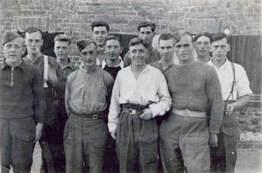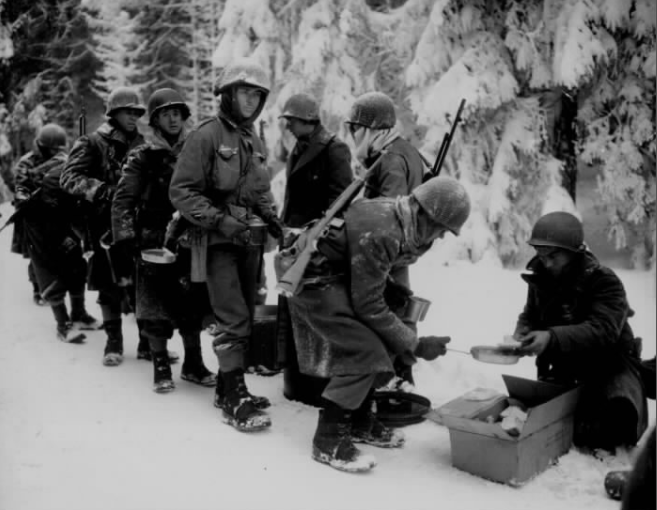No one battling in Europe in 1944 knew that this would be the last Christmas of the war. Americans didn’t know they were halfway through the Battle of the Bulge, the major German offensive that had begun December 16 and would end late in January, 1945. This battle, also known as the Ardennes Offensive, raged throughout the densely forested Ardennes region between Belgium and Luxembourg during what was one of the area’s coldest winters on record. About 8 inches of snow lay on the on the ground, and the temperature averaged of 20 degrees Fahrenheit. Christmas was definitely not celebrated in style among the troops. In front line hospitals, Bing Crosby’s “White Christmas” played on an old gramophone and champagne was served, but nearby, piles of undelivered Christmas cards and packages were drenched with gasoline and set on fire to keep them out of German hands. Years later, Lt. Robert I. Kennedy recalled his Christmas dinner he shared with three other soldiers: “One can of hamburger patties and one can of mashed potatoes so cold they were almost frozen. No one had any mess kits or any utensils, so each man reached dirty, bare hands into one can for one patty and with the other dirty hand for a fistful of mashed potatoes.” Life was a little better for Americans who had already been captured. At Stalag Luft III in Sagan, Poland, temperatures hovered just below 0°F, but at least the men were in barracks instead of foxholes. The American Red Cross had packed and shipped 75,000 Christmas parcels containing canned turkey, fruit cake, tobacco, games, and Christmas decorations during the summer of 1944. Kriegies, the English slang for the German Kriegsgefangenen or prisoner of war, used those packages to celebrate. The prisoners in Stalag Luft III wrote that they had a gigantic “bash,” and were allowed to roam the grounds. Alcohol, made by fermenting raisins from aid packages, flowed in several camps. Many camps had Christmas concerts and services. The Christmas pageant at Stalag Luft III was so well attended that not all of the 11,000 POWs were able to attend in the 700 seat auditorium, even though they gave multiple performances. German guards in Stalag VIIA gave their prisoners small Christmas trees from guards, which the men decorated with snowflakes cut from tin cans, lint, food labels, and nails.  Donald G. Cassidy Collection (AFC/2001/001/1599), Veterans History Project, American Folklife Center, Library of Congress Donald G. Cassidy Collection (AFC/2001/001/1599), Veterans History Project, American Folklife Center, Library of CongressDonald G. Cassidy, who was a Technical Sergeant in the 570th Bomb Squadron, 390th Bomb Group, 8th Air Force, spent Christmas of 1944 in Stalag XVIIB, just outside of the village of Krems, Austria. When he’d first arrived, in December of 1943, he and the other prisoners each received their own Red Cross parcels. Eventually, the supplies dwindled. Guards explained that American planes were bombing the Red Cross supplies. They began dividing parcels between two men when they got them at all. To make up for the loss of parcels, the Germans gave the POWs soap on occasion. The POWs also got ersatz coffee, a coffee substitute made from the taproots of chicory, soybeans, barley, and grains and formed into bricks, and sauerkraut, but the POWs found both so bad tasting that they used it for fuel.  Ministry of Information Photo Division Photographer, Public domain, via Wikimedia Commons Ministry of Information Photo Division Photographer, Public domain, via Wikimedia CommonsMeanwhile at home, families managed as best as they could. Rationing of sugar and butter made cookie making challenging. Many had to forego the Christmas turkey, since so much of the supply was sent overseas for the troops. Children’s toys were manufactured from wood and paper since metal, rubber, and rayon were all rationed for the war effort. Worst of all was the absence of so many men, and the fears that they might not come back at all, It’s no wonder that many of the songs released during the war, including “White Christmas” (1941), “I’ll Be Home for Christmas” (1943), and “Have Yourself a Merry Little Christmas” (1944) have a melancholy air to them.  Jennifer Bohnhoff writes historical and contemporary fiction for middle grade through adult readers. Her novel, Code: Elephants on the Moon tells the story of a young French woman who joins the Resistance as D-Day approaches. |







No comments:
Post a Comment